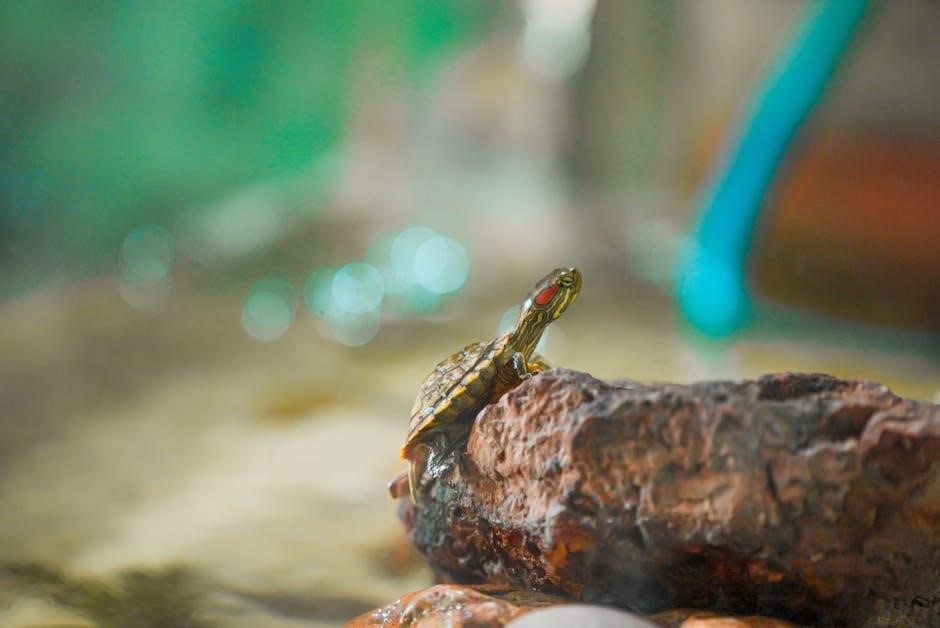Ecology and Ecosystems
Ecosystems rely on energy flow and nutrient cycles to sustain life. Biomes, like forests and deserts, have unique characteristics shaped by climate and species interactions. Human activities often disrupt these balances, impacting biodiversity and ecosystem services. Understanding these dynamics is crucial for environmental sustainability.
1.1 Energy Flow and Nutrient Cycles
In ecosystems, energy flows through food chains and food webs, starting with producers like plants that capture sunlight via photosynthesis; Consumers, such as herbivores and carnivores, transfer energy by eating other organisms. Only about 10% of energy is passed to the next trophic level, making energy flow inefficient. Decomposers, like bacteria and fungi, break down dead organisms, returning nutrients to the environment. Nutrient cycles, such as carbon, nitrogen, and phosphorus, sustain life by recycling essential elements. These cycles ensure nutrients are available for producers, maintaining ecosystem balance. Human activities, such as fertilizer use, can disrupt these cycles, leading to environmental issues like eutrophication. Understanding energy flow and nutrient cycles is vital for managing ecosystems and addressing environmental challenges.
1.2 Biomes and Their Characteristics
Biomes are large, naturally occurring communities of plants and animals that occupy specific habitats. Terrestrial biomes include forests, grasslands, and deserts, each characterized by unique vegetation and climate conditions. Forests, such as tropical rainforests, are densely vegetated and support immense biodiversity. Grasslands, like savannas, have grasses and scattered trees, while deserts are arid with limited vegetation. Aquatic biomes, such as freshwater ecosystems (rivers, lakes) and marine ecosystems (coral reefs, oceans), host a variety of aquatic life. Each biome is shaped by factors like temperature, precipitation, and geography, influencing the adaptations of its inhabitants. Understanding biomes is essential for appreciating biodiversity and addressing environmental challenges, as human activities like deforestation and pollution threaten these ecosystems. Biomes play a critical role in global processes, such as carbon cycling and water purification, making their conservation vital for ecological balance and human well-being.
1.3 Human Impact on Ecosystems
Human activities significantly alter ecosystems, often leading to environmental degradation. Deforestation, pollution, and climate change disrupt biodiversity and ecosystem balance. Resource exploitation, such as overfishing and mining, depletes natural resources and harms habitats. Greenhouse gas emissions contribute to global warming, causing rising sea levels and extreme weather events. Urbanization and agriculture further fragment ecosystems, reducing wildlife habitats. Pollution from plastics, chemicals, and industrial waste contaminates air, water, and soil, affecting both flora and fauna. Additionally, invasive species introduced by human activity outcompete native species, destabilizing ecosystems. These impacts highlight the need for sustainable practices, such as renewable energy, recycling, and conservation efforts, to mitigate environmental damage and preserve ecosystems for future generations. Understanding human impacts is crucial for developing strategies to protect and restore ecosystems, ensuring ecological health and biodiversity. Addressing these challenges requires global cooperation and individual responsibility to foster a sustainable relationship with the environment.
1.4 Biogeochemical Cycles
Biogeochemical cycles are essential for maintaining life on Earth, as they regulate the flow of nutrients through ecosystems. The carbon cycle, nitrogen cycle, phosphorus cycle, and water cycle are among the most critical. These cycles ensure that nutrients are continuously cycled between the environment and living organisms, supporting growth and energy production. The carbon cycle involves the exchange of carbon dioxide between the atmosphere, oceans, and land, with processes like photosynthesis and respiration playing key roles. The nitrogen cycle converts nitrogen into forms usable by plants and animals, such as ammonia and nitrates, through processes like nitrogen fixation and denitrification. The phosphorus cycle, while slower, is vital for DNA and ATP production. Human activities, such as fossil fuel combustion and agriculture, often disrupt these cycles, leading to imbalances like climate change and water pollution. Understanding these cycles is crucial for managing ecosystems and promoting sustainability. They highlight the interconnectedness of life and the environment, emphasizing the need to preserve ecological balance.
Genetics
Genetics explores heredity, DNA structure, and gene expression. Mendelian laws explain inheritance patterns, while DNA replication and genetic engineering techniques reveal how traits are passed and modified. Biotechnology applications impact fields like medicine and agriculture.
2.1 Mendelian Genetics and Inheritance
Mendelian genetics, developed by Gregor Mendel, is the foundation of heredity studies. It explains how traits are inherited through the transmission of genes from one generation to the next. Mendel’s laws of segregation and independent assortment describe how genes separate and combine during gamete formation. These principles are essential for understanding inheritance patterns, such as dominant and recessive traits. Punnett squares are tools used to predict the probability of offspring traits. Modern genetics builds on Mendel’s work, incorporating DNA structure and molecular mechanisms. The study of Mendelian genetics is crucial for understanding human health, agricultural breeding, and evolutionary biology. By analyzing genetic crosses and ratios, scientists can identify how specific traits are inherited and predict genetic outcomes. This knowledge has practical applications in fields like medicine, biotechnology, and environmental science, making it a cornerstone of biological studies.
2.2 DNA Structure and Replication
DNA (deoxyribonucleic acid) is a double-stranded helix made of sugar-phosphate backbones and nitrogenous bases. The bases—adenine (A), thymine (T), cytosine (C), and guanine (G)—pair specifically: A-T and C-G. This structure allows for efficient data storage and replication. DNA replication is semi-conservative, meaning each new molecule contains one original strand and one newly synthesized strand. The process begins with helicase unwinding the DNA, followed by primase adding primers. DNA polymerase then synthesizes the complementary strands, ensuring high fidelity. Repair mechanisms correct errors, maintaining genetic integrity. This precise replication is vital for heredity and cellular function, enabling the transmission of genetic information across generations. Understanding DNA replication is fundamental for genetics, biotechnology, and medicine, as it underpins life’s continuity and diversity.
2.3 Genetic Engineering Techniques
Genetic engineering involves manipulating DNA to introduce desired traits into organisms. Key techniques include restriction enzymes, which cut DNA at specific sequences, and ligases, which join DNA fragments. Plasmid vectors are commonly used to transfer genes into host cells, such as bacteria; Polymerase chain reaction (PCR) amplifies DNA segments for cloning. CRISPR-Cas9, a precise gene-editing tool, allows targeted modifications by disrupting and repairing DNA at specific locations. These methods enable the creation of transgenic organisms, such as pest-resistant crops. Ethical considerations, like unintended consequences and biodiversity impacts, are essential in regulating these technologies. Genetic engineering has revolutionized medicine, agriculture, and biotechnology, offering solutions to global challenges. Proper regulation ensures responsible use, balancing innovation with environmental and human safety concerns. Understanding these techniques is crucial for advancing biotechnology while addressing ethical dilemmas.
2.4 Biotechnology Applications
Biotechnology has transformed industries through innovative applications in medicine, agriculture, and environmental science. In medicine, genetic engineering produces insulin for diabetes treatment and monoclonal antibodies for cancer therapy. Vaccines are developed using recombinant DNA technology, enhancing global health. In agriculture, genetically modified organisms (GMOs) improve crop yields and resistance to pests, addressing food security challenges. Bioremediation uses microorganisms to clean pollutants from contaminated environments, restoring ecosystems. Biotechnology also advances forensic science through DNA fingerprinting, aiding criminal investigations. Additionally, biofuels like ethanol and biodiesel reduce reliance on fossil fuels, promoting sustainable energy solutions. These applications highlight the potential of biotechnology to solve complex problems, from disease treatment to environmental conservation. Ethical considerations, such as safety and equity, guide responsible innovation in this field. As research progresses, biotechnology continues to offer promising solutions for future challenges, ensuring a healthier and more sustainable world.

Evolution
Evolution explains how species adapt and change over time through natural selection and genetic variation. Fossil records, comparative anatomy, and molecular biology provide evidence, demonstrating life’s diversity and common ancestry.
3.1 Mechanisms of Evolution
Evolution occurs through several mechanisms that drive changes in populations over generations. Natural selection, a key driver, favors individuals with traits that enhance survival and reproduction in specific environments. Genetic drift, often due to chance events, alters allele frequencies, especially in small populations. Mutation introduces new genetic variations, providing raw material for evolution. Gene flow, the movement of individuals with unique traits into a population, increases genetic diversity. Non-random mating patterns, such as assortative mating, influence the distribution of traits without directly driving evolution. These mechanisms interact, shaping the genetic composition of populations and leading to adaptation and speciation over time. Understanding these processes is essential for grasping how life on Earth has diversified and continues to change in response to environmental pressures.
3;2 Evidence for Evolution
The theory of evolution is supported by multiple lines of evidence. The fossil record reveals a chronological progression of life forms, showing gradual changes over time. Comparative anatomy highlights homologous structures across species, indicating common ancestry. Molecular biology provides evidence through DNA and protein similarities, demonstrating genetic relatedness. Biogeography explains the geographic distribution of species based on evolutionary history. Observations of natural selection in action, such as antibiotic resistance in bacteria, confirm evolutionary processes. Additionally, transitional fossils and embryological similarities further reinforce the theory. Together, these pieces of evidence form a cohesive framework that validates the principles of evolution, illustrating how species adapt and diversify over generations. These findings are consistent with scientific observations and experimental data, making evolution a fundamental concept in biology. Understanding this evidence is crucial for grasping the dynamic nature of life on Earth.
3.3 Speciation and Phylogeny
Speciation is the process by which new species emerge, often due to reproductive isolation. This can occur through geographical barriers or genetic drift, leading to distinct species that can no longer interbreed. Phylogeny, the study of evolutionary relationships, uses shared characteristics, DNA sequences, and fossil records to construct phylogenetic trees. These trees illustrate how species diverge over time. For example, the Galapagos finches evolved into different species due to varying environmental pressures. Understanding speciation and phylogeny helps explain biodiversity and how life adapts to ecological niches. These concepts are vital for tracing evolutionary history and predicting future adaptations. By analyzing genetic and morphological data, scientists can map the branching patterns of life, revealing the interconnectedness of all organisms. This knowledge enhances our appreciation of Earth’s complex biosphere and the dynamic processes that shape it. Studying speciation and phylogeny provides insights into the shared ancestry of life on Earth.
3.4 Evolutionary Biology and Medicine
Evolutionary biology provides critical insights into understanding diseases and developing medical treatments. By studying evolutionary principles, scientists can trace the origins of pathogens, such as viruses and bacteria, and how they adapt to evade the immune system. This knowledge helps in predicting future mutations and designing effective vaccines. For instance, the rapid evolution of antibiotic resistance in bacteria highlights the need for new therapeutic strategies. Evolutionary medicine also explains why certain genetic disorders persist, offering clues for personalized treatments. Additionally, studying the evolutionary history of humans reveals how past environments shaped our physiology, influencing susceptibility to modern diseases like diabetes and hypertension. Applying evolutionary perspectives to medicine fosters innovative solutions, such as targeting evolutionary Achilles’ heels in pathogens. This interdisciplinary approach bridges biology and healthcare, enhancing our ability to combat diseases and improve public health. By integrating evolutionary concepts, medicine becomes more proactive and adaptable to emerging health challenges.
Laboratory Manual
The lab manual is essential for conducting scientific investigations. It includes microscope use, scientific measurements, and lab safety protocols. Proper data analysis and graphing techniques are emphasized to ensure accurate and reliable results.
4.1 Use of the Microscope
The microscope is a fundamental tool in biology for observing microscopic structures. Proper setup involves placing the microscope on a level surface and ensuring the light source is adjusted for optimal illumination. Begin with the low-power objective lens to focus on the specimen, then switch to higher magnification for detailed observations. Use the stage clips to secure the slide, and adjust the condenser for clear resolution. Always handle slides and lenses with care to avoid damage. Regular maintenance, such as cleaning lenses and checking light intensity, ensures functionality. Students should practice focusing techniques and learn to identify key structures in prepared slides. This skill is essential for understanding cellular biology and other microscopic phenomena in the living environment.
4.2 Scientific Measurement and Tools
Accurate measurement is critical in scientific investigations. Biologists use tools like metric rulers, graduated cylinders, and balances to measure length, volume, and mass. Precision and accuracy are key to reliable data collection. Calibration of instruments ensures consistency, while SI units (e.g., meters, liters, grams) standardize measurements globally; Temperature is measured using thermometers, often in Celsius or Kelvin for scientific contexts. Electronic devices, such as spectrophotometers, enhance accuracy in specialized measurements. Proper handling and maintenance of tools prevent errors and extend their lifespan. Understanding measurement techniques is foundational for experimental design and data analysis in the living environment. Regular practice with these tools helps students develop proficiency in recording and interpreting scientific data effectively.
4.3 Lab Safety Protocols
Lab safety protocols are essential to protect students and equipment during experiments. Key measures include wearing personal protective equipment (PPE) like gloves, goggles, and lab coats. Students must follow rules such as no eating, drinking, or horseplay in the lab. Chemicals should be handled carefully, with proper labeling and storage. Emergency equipment like fire extinguishers, eye wash stations, and first aid kits must be accessible. Students should know procedures for spills, burns, and broken glass. Proper disposal of hazardous materials is critical. Before starting, reviewing safety data sheets (SDS) for chemicals ensures awareness of potential risks. Supervision by trained professionals minimizes accidents. Clear communication and adherence to instructions are vital. Labs should be cleaned up thoroughly after use, with all equipment returned and surfaces sanitized. Following these protocols ensures a safe learning environment and minimizes risks during scientific investigations.
4.4 Data Analysis and Graphing
Data analysis and graphing are critical skills in scientific inquiry, enabling students to interpret and communicate findings effectively. Accurate data collection is the foundation, ensuring reliability in results. Organizing data into tables or charts helps identify patterns and trends. Graphs such as line graphs, bar graphs, and pie charts are used to visualize data, with line graphs showing trends over time, bar graphs comparing groups, and pie charts illustrating proportions. Proper labeling, including titles, axes, and legends, is essential for clarity. Students should interpret graphs by identifying maxima, minima, and correlations, while avoiding assumptions beyond the data. Common errors include misreading axes or drawing unsupported conclusions. Practicing graphing techniques and data interpretation builds proficiency in understanding and presenting scientific information clearly and accurately.

Biodiversity
Biodiversity refers to the variety of life on Earth, encompassing genes, species, and ecosystems. It is essential for maintaining healthy ecosystems, as diverse species contribute to ecological balance and resilience. Key components of biodiversity include genetic diversity, species diversity, and ecosystem diversity. Genetic diversity within species ensures adaptability to environmental changes, while species diversity supports complex food webs and nutrient cycling. Ecosystem diversity provides a range of habitats, from forests to oceans, each hosting unique communities of organisms. Threats to biodiversity, such as habitat destruction, pollution, invasive species, and climate change, can disrupt ecosystems and lead to species extinction. Preserving biodiversity is crucial for maintaining ecosystem services like pollination, clean water, and carbon sequestration. Understanding biodiversity helps in developing conservation strategies to protect and restore ecosystems, ensuring the survival of species and the health of the planet for future generations. By studying biodiversity, students gain insights into the interconnectedness of life and the importance of environmental stewardship.

Human Impact on the Environment
Human activities significantly influence the environment, often leading to ecological imbalances. Deforestation, industrialization, and pollution release greenhouse gases, contributing to climate change and habitat destruction. Resource overexploitation depletes natural reserves, while waste accumulation harms ecosystems. Additionally, urbanization and agriculture disrupt natural habitats, leading to biodiversity loss. Conservation efforts like recycling, renewable energy adoption, and sustainable practices can mitigate these impacts. Educating communities about environmental stewardship is vital to promote eco-friendly behaviors. By addressing these challenges, humanity can work toward preserving the planet for future generations, ensuring a balance between development and environmental health. Understanding these impacts is crucial for creating effective strategies to protect Earth’s ecosystems and resources.

Cell Biology
Cell biology explores the structure, function, and processes of cells, the fundamental units of life. Cells consist of organelles like mitochondria, ribosomes, and chloroplasts, each performing specialized roles. The cell membrane regulates material transport through passive and active mechanisms. Photosynthesis occurs in chloroplasts, converting light energy into chemical energy, while cellular respiration in mitochondria generates ATP. Cell division, including mitosis and meiosis, ensures growth and reproduction. Understanding cellular processes is essential for studying genetics, evolution, and human health, as cells are the building blocks of all living organisms.

Study Strategies for Success
Mastering the Living Environment Regents exam requires effective study strategies. Start by breaking down complex topics into manageable sections, focusing on key concepts like ecology, genetics, and evolution. Active learning techniques, such as creating flashcards or concept maps, can enhance retention. Practice past exams to familiarize yourself with the format and timing. Use online resources like Gemini Deep Research for in-depth analysis of challenging subjects. Organize your study schedule, allocating specific times for each topic to ensure comprehensive coverage. Engage in group studying to discuss and clarify doubts. Additionally, utilize digital tools like Ecosia for environmentally conscious searching and reference credible websites for supplementary materials. Regularly review and reflect on your progress to identify areas needing improvement. By combining these strategies, you can build a strong foundation and confidently approach the exam.
